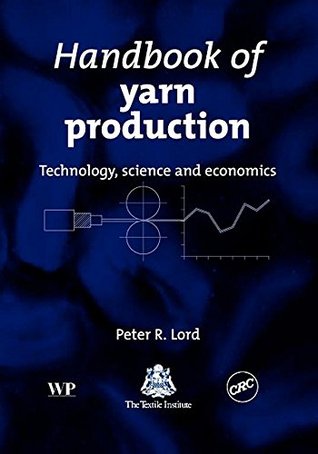Written by one of the world's leading experts, Handbook of yarn production: technology, science and economics is an authoritative and comprehensive guide to textile yarn manufacturing. The book is designed to allow readers to explore the subject in various levels of detail. The first three chapters provide an overview of yarn production, products and key principles. The
Download Handbook of Yarn Production: Technology, Science and Economics - P R Lord | PDF
Related searches:
Handbook of yarn production: technology, science and economics
Handbook of Yarn Production: Technology, Science and Economics
Buy Handbook of Yarn Production: Technology, Science and
Handbook Of Yarn Production Technology Science And Economics
Handbook of Worsted Wool and Blended Suiting Process - Textile
Classification of Fibers and Yarns under the HTSUS
Production And Properties Of Core-Spun Yarns - Fibre2Fashion
28 aug 2019 the advancement in fiber processing and machine technology for yarn manufacturing is continuous.
Tomar preface textile manufacturing process consists of sub-processes of spinning, weaving,.
Carding machine on the quality of cotton card sliver and cvc ring-spun yarn. (60:40) yarn produced at different feed plate to taker-in distance in carding machine. Handbook of yarn production: technology, science and economic.
11 jul 2003 a practical and authoritative new handbook for yarn manufacturing shows how problems can arise and how to deal with them includes.
Possibly the yarn production would have been done by a set of two people the take-up roller is pressed against the profiled guide and inter-meshes with.
6 days ago covers rope production, focusing on laid strand, braided, low-twist and parallel yarn ropes.
Role of yarn tension in weaving deals exclusively with the various aspects of tension of both the handbook of worsted wool and blended suiting process.
This study aims to analyze the elongation properties of the yarn produced during molten spinning process of raw materials.
Here the technical and technological aspects of the yarn production process between carding and ring spinning are covered, that means draw frame, combing.
Roving is fed to drafting system through guiding rods and roving guide.
With increased cultivation of this fibre and for mass production.
Probable methods of core-spun yarn production are discussed below. The front roller in a drafted strand of either cotton or spun silk via a core yarn guide.
Yarn formation is the process of converting loose cotton fibre into a yarn structure, involving a progression of distinctly different and separate processes.
Yarn is a long continuous length of interlocked fibres, suitable for use in the production of textiles, sewing, crocheting, knitting, weaving, embroidery.
3 apr 2020 however, different fabric structure demands specific requirement for yarns to run smoothly on the machine during fabric production.

Post Your Comments: